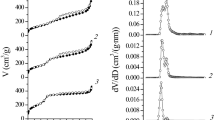Abstract
The phase transition behaviors of organic liquids condensed in the silica mesopores which modified with organic functional groups have been investigated. Three organic liquids, n-hexane, 1-hexanol and acetonitrile, were employed. The melting points of the organic liquids in the pores with and without the organic functional groups decreased with decreasing the pore size. The effect of the organic functional groups on the change in the physical properties of the organic condensed liquids in the pores was estimated from a depression of the melting point. The phase transition behaviors of the organic liquids in the pores closely related to the interaction between the organic molecules and the pore surfaces.




Similar content being viewed by others
References
Rouquerol F, Rouquerol J, Sing K. Adsorption by powders and porous solids: principles, methodology and applications. London: Academic Press; 1999. pp. 191–217.
Brun M, Lallemand A, Quinson JF, Eyraud C. A new method for the simultaneous determination of the size and the shape of pores: the thermoporometry. Thermochim Acta. 1977;21:59–88.
Ishikiriyama K, Todoki M. Pore size distribution measurements of silica gels by means of differential scanning calorimetry. II. Thermoporometry. J Colloid Interface Sci. 1995;171:103–11.
Riikonen J, Salonen J, Lehto V-P. Utilising thermoporometry to obtain new insights into nanostructured materials. Review part 1. J Therm Anal Calorim. 2011;105:811–21.
Riikonen J, Salonen J, Lehto V-P. Utilising thermoporometry to obtain new insights into nanostructured materials. Review part 2. J Therm Anal Calorim. 2011;105:823–30.
Zeman L, Tkacik G, Parlouer P. Characterization of porous sublayers in UF membranes by thermoporometry. J Membrane Sci. 1987;32:329–37.
Quinson JF, Mameri N, Guihard L, Bariou B. The study of the swelling of an ultrafiltration membrane under the influence of solvents by the thermoporometry and measurement of permeability. J Membrane Sci. 1991;58:191–200.
Beurroies I, Denoyel R, Llewllyn P, Rouquerol J. A comparison between melting-solidification and capillary condensation hysteresis in mesoporous materials: application to the interpretation of thermoporometry data. Thermochim Acta. 2004;421:11–8.
Endo A, Yamamoto T, Inagaki Y, Iwakabe K, Ohmori T. Characterization of nonfreezable pore water in mesoporous silica by thermoporometry. J Phys Chem C. 2008;112:9034–9.
Cides da Silva LC, Araújo GLB, Segismundo NR, Moscardini EF, Mercuri LP, Cosentino IC, Fantini MC, Matos JR. DSC estimation of structural and textural parameters of SBA-15 silica using water probe. J Therm Anal Calorim. 2009;97:701–4.
Bahloul N, Baba M, Nedelec J-M. Universal behavior of liner alkanes in a confined medium: toward a calibrationless use of thermoporometry. J Phys Chem B. 2005;109:16227–9.
Illeková E, Krištiak J, Macová E, Maťko I, Šauša O. Rearrangement of hexadecane molecules confined in the nanopores of a controlled pore glass using positron annihilation and differential scanning calorimetry. J Therm Anal Calorim. 2013;113:1187–96.
Landry MR. Thermoporometry by differential scanning calorimetry: experimental considerations and applications. Thermochim Acta. 2005;433:27–50.
Nedelec J-M, Grolier J-E, Baba M. Thermoporosimetry: a powerful tool to study the cross-linking in gels networks. J Sol Gel Sci Technol. 2006;40:191–200.
Wulff M. Pore size determination by thermoporometry using acetonitrile. Thermochim Acta. 2004;419:291–4.
Kittaka S, Kuranishi M, Ishimaru S, Umahara O. Low temperature properties of acetonitrile confined in MCM-41. J Phys Chem B. 2005;109:23162–9.
Takei T, Onoda Y, Fuji M, Watanabe T, Chikazawa M. Anomalous phase transition behavior of carbon tetrachloride in silica pores. Thermochim Acta. 2000;352–353:199–204.
Meziane A, Grolier J-PE, Baba M, Nedelec J-M. Crystallization of carbon tetrachloride in confined geometries. Faraday Discuss. 2007;136:383–94.
Husár B, Commereuc S, Lukáč I, Chmela S, Nedelec J-M, Baba M. Carbon tetrachloride as a thermoporometry liquid probe to study the cross-linking of stylene copolymer networks. J Phys Chem B. 2006;110:5315–20.
Levitz P, Ehret G, Shinha SK, Drake JM. Porous vycor glass: the microstructures as probed by electron microscopy, direct energy transfer, small-angle scattering, and molecular adsorption. J Chem Phys. 1991;95:6151–61.
Iler RK. The chemistry of silica. New York: Wiley; 1979. pp. 479–488.
Beck JS, Vartuli JC, Roth WJ, Leonowicz ME, Kresge CT, Schmitt KD, Chu CT-W, Olson DH, Sheppard EW, McCullen SB, Higgins JB, Schlenker JL. A new family of mesoporous molecular sieves prepared with liquid crystal templates. J Am Chem Soc. 1992;114:10834–43.
Grulke EA. Solubility parameter values. In: Brandrup J, Immergut EH, Grulke EA, editors. Polymer handbook. Hoboken: Wiley; 1999. p. 675–714.
Barrow MJ. α-Acetnitrile at 215 K. Acta Cryst. 1981;B37:2239–42.
Antson OK, Tilli KJ, Andersen NH. Neutron powder diffraction study of deuterated β-acetonitrile. Acta Cryst. 1987;B43:296–301.
Takei T, Konishi T, Fuji M, Watanabe T, Chikazawa M. Phase transition of capillary condensed liquids in porous silica: effect of surface hydroxyl groups. Thermochim Acta. 1995;267:159–67.
Takei T, Yamazaki A, Watanabe T, Chikazawa M. Water adsorption properties on porous silica glass surface modified by trimethylsilyl groups. J Colloid Interface Sci. 1997;188:409–14.
Tsutsumi K, Takahashi H. Studies of surface modification of solids. Colloid Polym Sci. 1985;263:506–11.
Fuji M, Ueno S, Takei T, Watanabe T, Chikazawa M. Surface structural analysis of fine silica powder modified with butyl alcohol. Colloid Polym Sci. 2000;278:30–6.
Haukka S, Root A. The reaction of hexamethyldisilazane and subsequent oxidation of trimethylsilyl groups on silica studied by solid-state NMR and FTIR. J Phys Chem. 1994;98:1695–703.
Author information
Authors and Affiliations
Corresponding author
Additional information
The present article is based on the lecture presented at JCCTA50 conference in Osaka—Japan on 28–30 September, 2014.
Rights and permissions
About this article
Cite this article
Takei, T., Nakada, M., Yoshikawa, N. et al. Effect of organic functional groups on the phase transition of organic liquids in silica mesopores. J Therm Anal Calorim 123, 1787–1794 (2016). https://doi.org/10.1007/s10973-015-4907-3
Received:
Accepted:
Published:
Issue Date:
DOI: https://doi.org/10.1007/s10973-015-4907-3




